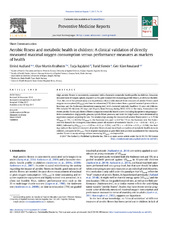| dc.contributor.author | Aadland, Eivind | |
| dc.contributor.author | Kvalheim, Olav Martin | |
| dc.contributor.author | Rajalahti, Tarja | |
| dc.contributor.author | Skrede, Turid | |
| dc.contributor.author | Resaland, Geir Kåre | |
| dc.date.accessioned | 2018-03-01T12:42:28Z | |
| dc.date.available | 2018-03-01T12:42:28Z | |
| dc.date.issued | 2017-09 | |
| dc.Published | Aadland E, Kvalheim OM, Rajalahti T, Skrede T, Resaland GK. Aerobic fitness and metabolic health in children: A clinical validation of directly measured maximal oxygen consumption versus performance measures as markers of health. Preventive Medicine Reports. 2017;7:74-76 | eng |
| dc.identifier.issn | 2211-3355 | en_US |
| dc.identifier.uri | https://hdl.handle.net/1956/17437 | |
| dc.description.abstract | High aerobic fitness is consistently associated with a favorable metabolic health profile in children. However, measurement of oxygen uptake, regarded as the gold standard for evaluating aerobic fitness, is often not feasible. Thus, the aim of the present study was to perform a clinical validation of three measures of aerobic fitness (peak oxygen consumption [VO2peak] and time to exhaustion [TTE] determined from a graded treadmill protocol to exhaustion, and the Andersen intermittent running test) with clustered metabolic health in 10-year-old children. We included 93 children (55 boys and 38 girls) from Norway during 2012–2013 in the study. Associations between aerobic fitness and three different composite metabolic health scores (including lipoprotein subgroup particle concentrations, triglyceride, glucose, systolic blood pressure, and waist-to-height ratio) were determined by regression analyses adjusting for sex. The relationships among the measures of aerobic fitness were r = 0.78 for VO2peak vs. TTE, r = 0.63 for VO2peak vs. the Andersen test, and r = 0.67 for TTE vs. the Andersen test. The Andersen test showed the strongest associations across all markers of metabolic health (r = − 0.45 to − 0.31, p < 0.002), followed by VO2peak (r = − 0.35 to − 0.12, p < 0.256), and TTE (r = − 0.28 to − 0.10, p < 0.334). Our findings indicate that indirect measures of aerobic fitness do not stand back as markers of metabolic health status in children, compared to VO2peak. This is of great importance as good field tests provide opportunities for measuring aerobic fitness in many settings where measuring VO2peak are impossible. | en_US |
| dc.language.iso | eng | eng |
| dc.publisher | Elsevier | en_US |
| dc.rights | Attribution CC BY-NC-ND | eng |
| dc.rights.uri | http://creativecommons.org/licenses/by-nc-nd/4.0/ | eng |
| dc.subject | Cardiorespiratory fitness | eng |
| dc.subject | Metabolic syndrome | eng |
| dc.subject | Measurement | eng |
| dc.subject | Validation | eng |
| dc.title | Aerobic fitness and metabolic health in children: A clinical validation of directly measured maximal oxygen consumption versus performance measures as markers of health | en_US |
| dc.type | Peer reviewed | |
| dc.type | Journal article | |
| dc.date.updated | 2018-02-05T10:15:19Z | |
| dc.description.version | publishedVersion | en_US |
| dc.rights.holder | Copyright 2017 The Author(s) | en_US |
| dc.identifier.doi | https://doi.org/10.1016/j.pmedr.2017.05.001 | |
| dc.identifier.cristin | 1483984 | |
| dc.source.journal | Preventive Medicine Reports | |

